A Look at Ophiuchus, Aphelion for Earthlings, Mighty Planets Post-midnight, Young Moon meets Mercury, and then Venus-Mars!
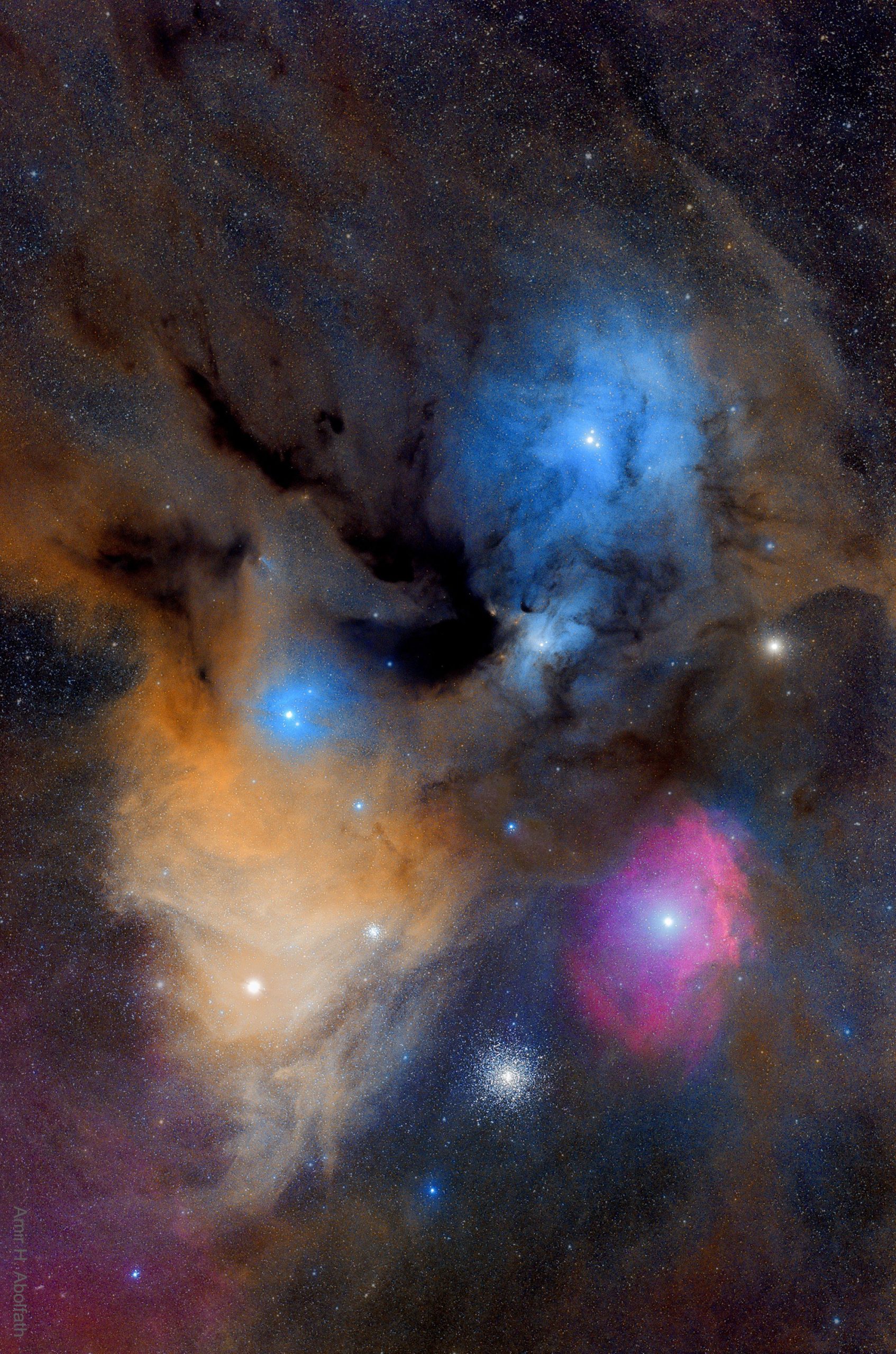
This terrific image by Amir H. Abolfath was featured in NASA’s Astronomy Picture of the Day (APOD) for October 14, 2020. The bright star inside the orange zone at lower left is Antares in Scorpius. The big and bright globular cluster Messier 4 sits to its lower right. The pink region is glowing hydrogen gas surrounding the star Alniyat (or Sigma Scorpii). The bright blue zone at the upper right is light scattered off dust in the triple star system of Rho Ophiuchi within it. Note the deep black shapes produced by opaque interstellar dust, and several more, smaller globular clusters. The area of sky in this image covers a palm’s width top to bottom.
Hello, July Stargazers!
Here are your Astronomy Skylights for the week of July 4th, 2021 by Chris Vaughan. Feel free to pass this along to your friends and send me your comments, questions, and suggested topics. You can also follow me on Twitter as @astrogeoguy! Unless otherwise noted, all times are expressed in Eastern Time. To subscribe to these emails please click this MailChimp link.
I can bring my Digital Starlab portable inflatable planetarium to your school or other daytime or evening event, or teach a session online. Contact me through AstroGeo.ca, and we’ll tour the Universe, or the Earth’s interior, together!
This week, the moon will absent from the evening sky all around the world – ideal for viewing the best stars and objects in Ophiuchus. In the western sky after sunset dim Mars and brilliant Venus draw very close together. All the planets can be observed between dusk and dawn for one more week! Read on for your Skylights!
Earth at Aphelion
On Monday, July 5 at 6 pm EDT, or 22:00 Greenwich Mean Time, Earth will reach aphelion, its maximum distance from the sun for this year. The aphelion distance of 152.1 million km is 1.67% farther from the sun than the mean Earth-sun separation of 149,597,870.7 km, which is also defined to be 1 Astronomical Unit or 1 A.U. Earth’s perihelion (minimum distance from the sun) will occur next January 4. At that time, the Earth will be 147.1 million km from the sun. As you can see, our seasonal temperatures are not produced by our distance from the sun – but by the amount of sunshine we receive in a day – and that is controlled by how much Earth’s axis tilts toward (or away from) the sun.
The Moon
The moon will continue to be absent from the evening and late night sky for everyone on Earth this week – which is great news for summer stargazers. To see Earth’s “junior sibling” you’ll need to be outside before sunrise during the first half of this week. On Monday morning, the waning crescent moon will shine on the border between Taurus (the Bull) and Aries (the Ram), a fist’s diameter to the right (celestial southwest) of the Pleiades star cluster. On Tuesday morning, the moon will migrate east to sit below that cluster and above another – the Hyades cluster. The Hyades’ stars form the triangular face of Taurus (the Bull). Look for the bright, orange, foreground star Aldebaran below them.
On Wednesday morning, the very slim crescent moon will rise at about 3:45 am local time. It will be positioned above and between Aldebaran and the somewhat brighter dot of Mercury, which will rise shortly before 4:30 am local time. For a brief period before sunrise on Thursday, the moon will be positioned several finger widths to the left (or 4 degrees to the celestial northeast) of Mercury. Look for the pair sitting very low over the east-northeastern horizon from the time they rise at about 4:20 am local time until about 5 am. The moon and Mercury will be close enough to share the view through binoculars – but turn your optics away before the sun rises.
The moon will officially reach its new phase on Friday, July 9 at 9:16 pm EDT, which corresponds to 01:16 GMT on Saturday, July 10. While new, the moon is travelling between Earth and the sun. Since sunlight can only reach the far side of the moon, and the moon is in the same region of the sky as the sun, the moon becomes unobservable from anywhere on Earth for about a day (except during a solar eclipse). The young crescent moon will sit low in the north-northwestern sky after sunset on Saturday – but it will be very hard to see.
After sunset on Sunday evening, the young, 4%-illuminated, crescent moon will shine a palm’s width to the right (or 6.5 degrees to the celestial northwest) of two planets – bright Venus and much fainter Mars. Before they set at about 10:30 pm local time, the trio will make a nice wide-field photo when composed with some interesting scenery.

The Planets
It will continue to be possible to see all of the planets between sunset and sunrise for one more week! Let’s tour them, in order.
After sunset, find somewhere with an unobstructed view of the west-northwestern sky and look for the extremely bright dot of Venus shining about a fist’s diameter above the horizon. Once the sky darkens more, the faint reddish dot of Mars will appear nearby. Look closely, though – because magnitude +1.83 Mars is nearly 200 times fainter than magnitude -3.85 Venus!
Tonight (Sunday) Mars will be positioned less than a palm’s width to Venus’ upper right (or 5 degrees to the celestial east). Next Sunday night Mars will be somewhat lower in the sky, and Venus will sit only a finger’s width to its right. They are converging because, while both Venus and Mars are travelling eastward along the ecliptic, slower Mars is not able to offset the westward migration of the sky, while Venus can. As Mars descends and Venus climbs, they appear to be traveling towards one another.
Next week, Venus will overtake and pass Mars, producing a conjunction of the two planets while they shine among the stars of Leo (the Lion). Venus will gleam as the “Evening Star” all year long, but Mars will soon disappear into the sunset and solar conjunction. For now, you can enjoy them until they set at about 10:30 pm local time.
At the present time, Venus is situated on the far side of the sun from Earth. That, plus its angle of about 27° from the sun, combine to make the planet look smaller than average and only 88% illuminated – producing a slightly squashed shape in your telescope. Aim your telescope at Venus as soon as you can find the planet. That way, it will be higher, and shining through less distorting atmosphere. But ensure that the sun has completely disappeared first!
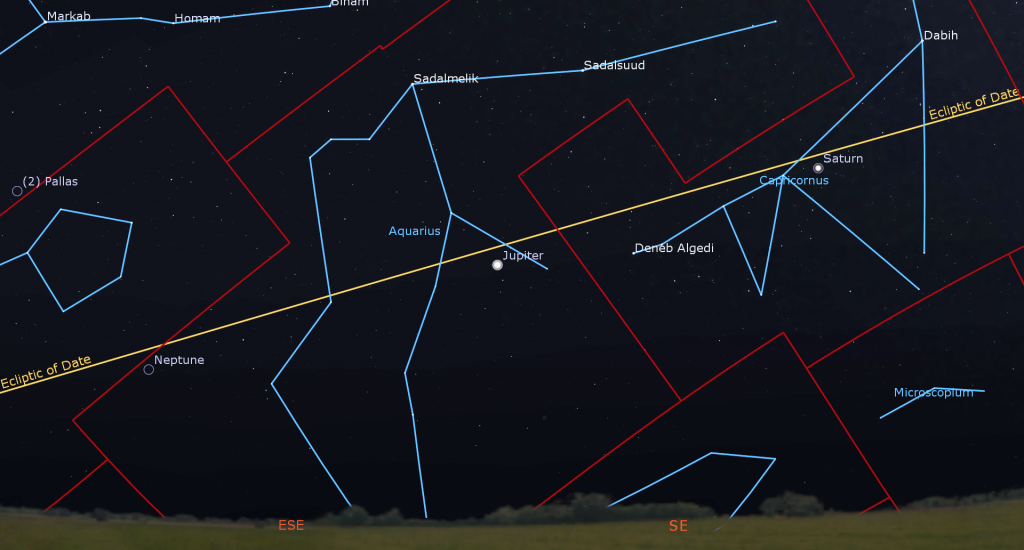
This week, yellow-tinted, magnitude 0.35 Saturn will rise within the stars of central Capricornus (the Sea-Goat) at about 10:30 pm local time and then linger to shine in the southwestern sky until just before dawn. Saturn is being pursued across the sky by 16-times brighter Jupiter. If you stay up late, or wake up early, to see the gas giant planets, watch for the Milky Way and the teapot-shaped stars of Sagittarius (the Archer) sitting several fist diameters off to Saturn’s right (celestial west).
Even a small telescope will show Saturn’s rings and several of its brighter moons – especially its largest moon, Titan! Because Saturn’s axis of rotation is tipped about 27° from its orbital plane (a bit more than Earth’s tilt), we can see the top surface of its rings, and its moons can arrange themselves above, below, or to either side of the planet. During this week, Titan will migrate counter-clockwise around Saturn, moving from the lower left (celestial east) of Saturn tonight (Sunday night) to the upper right (west) of the planet next Sunday. (Remember that your telescope will probably flip the view around.)
This week the very bright, white, magnitude -2.6 planet Jupiter will rise just after 11 pm local time, and then follow Saturn across the southern sky until sunrise hides them. Jupiter is now moving slowly westward across the distant stars of central Aquarius (the Water-Bearer), a parallax effect produced when Earth, on a faster orbit, passes Jupiter on the “inside track” around the sun.
For Eastern Time Zone observers the Great Red Spot (or GRS) will be visible crossing Jupiter during the wee hours of Monday, Wednesday and Friday, and before dawn on Tuesday and Sunday morning. From time to time, the small round black shadows cast by Jupiter’s four Galilean moons become visible in amateur telescopes when they cross (or transit) the planet’s disk. On Saturday morning from 4:53 am to 7 am EDT (or 08:53 to 11:00 GMT), Io’s small shadow will cross Jupiter. It will cross again on Sunday, July 11 starting at 11:20 pm EDT.
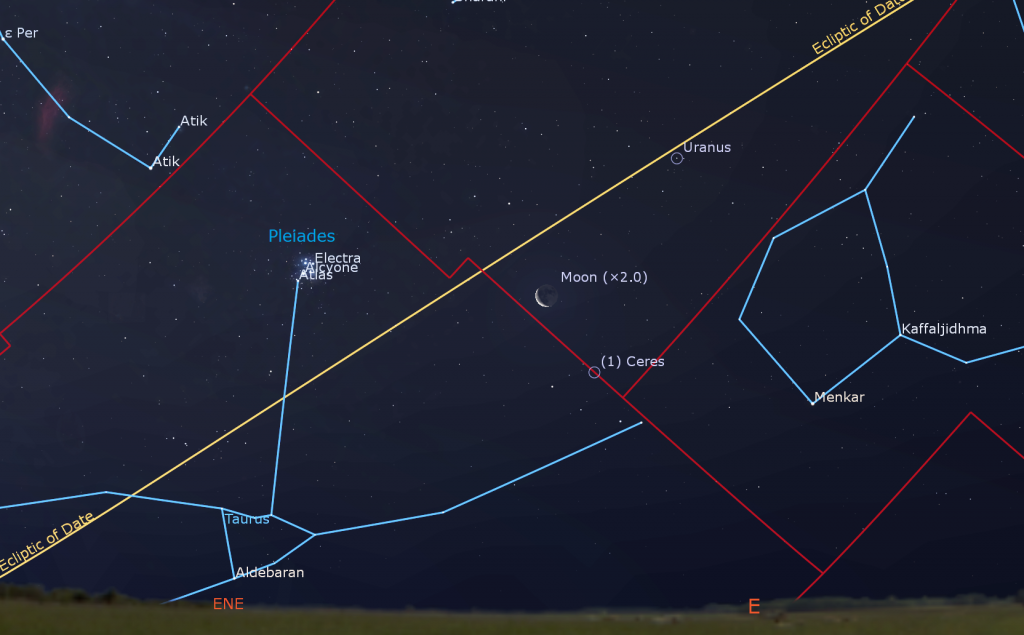
Dim, blue Neptune is following Jupiter across the sky. It rises at about midnight local time, and sits about 2 fist diameters to the left (or 21° to the celestial east) of Jupiter – near the border between Aquarius and Pisces (the Fishes). Magnitude 5.8 Uranus is bright enough to see in binoculars and backyard telescopes, even near cities. This week it will rise below the bright stars in Aries (the Ram) just before 2 am local time – but that time will move earlier by about half an hour per week.
Last up, literally, is Mercury, which will spend all of July in the eastern pre-dawn sky. Its position below (or to the celestial south of) the morning ecliptic will prevent Mercury from rising much before the sun – making this appearance a poor one for Northern Hemisphere observers, but a good one for people viewing the planet from south of the equator. Mercury reached greatest western elongation and peak visibility on this morning, Sunday, July 4, when it swung to 21.6° away from the sun. At mid-northern latitudes this week, the best time to see Mercury will be at about 5:15 am local time – but it will sit extremely low over the east-northeastern horizon.
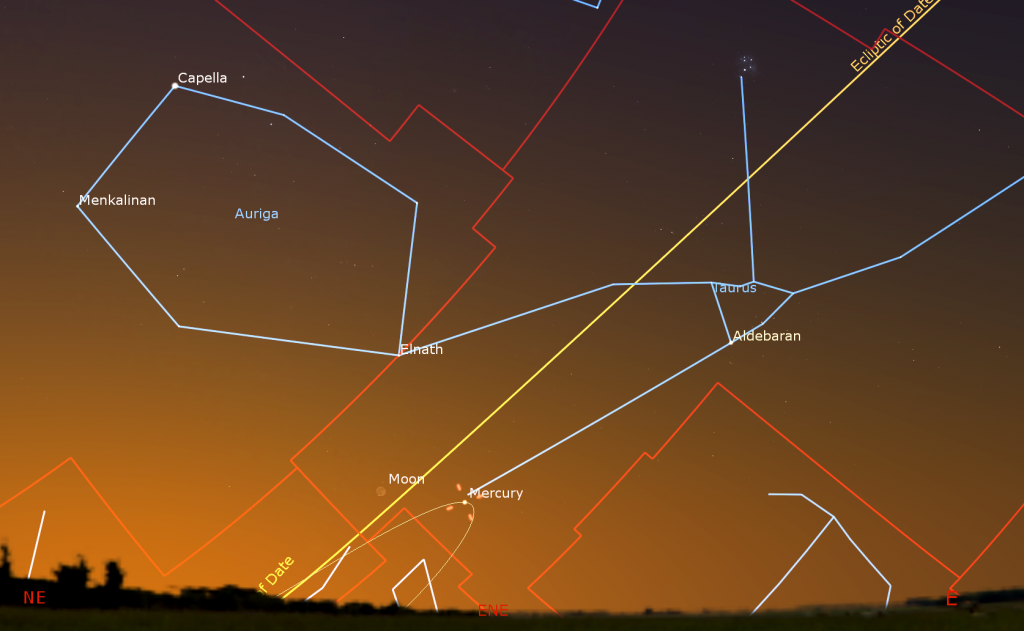
Viewed in a telescope (but only until just before sunrise) this week, the speedy planet will wax in illuminated phase from a squat 38%-lit crescent on Monday morning to half-illuminated next Sunday.
So – there you have it! You can see Venus and Mars after sunset, Jupiter and Saturn after midnight, Neptune and Uranus during the wee hours, and Mercury just before sunrise!
A Look at Ophiuchus
The moon’s move into morning is giving everyone darker skies this week – so let me introduce you to the cool sights in a lesser-known constellation named Ophiuchus (the Serpent-Bearer). But first – some zodiac-talk.
The twelve constellations of the zodiac are only famous and/or special because the great circle of the ecliptic carries the sun through each of them in turn. The sun spends varying amounts of time crossing each constellation, and the entry and exit dates repeat every year. For example, in the present era, the sun traverses the constellation of Gemini (the Twins) from June 21 to July 19. Remember, the sun isn’t moving – Earth’s orbital motion makes the sun appear to change location with respect to the fixed distant background stars.
Most of the Zodiac constellations are inconspicuous, if not nearly invisible, from the city and suburbs. Aries (the Ram) has two decently bright stars that form a little stick, while Cancer, Pisces (the Fishes), Aquarius (the Water Bearer), and Capricornus (the Goat) are seriously tough to make out – unless you travel to darker skies. A few constellations, Gemini (the Twins), Taurus (the Bull), Scorpius (the Scorpion), and Leo (the Lion), have very bright stars that form easily recognizable shapes. The rest of them fall into the medium-bright range.
If you’re an astrology enthusiast, you’ll be wondering by now – why is the sun traversing Gemini in June and July, when the Gemini “star sign” is for birthdays from May 22 to June 21? Well, thousands of years ago, when astrology was formulated by the Greeks and Babylonians, the sun traversed Gemini during that part of the year. It’s one of many reasons why most astronomers place no value in astrology, whatsoever. By the way – if you have an astronomy app or program that allows the year to be changed, you can prove this for yourself by setting the app to noon, centring on the sun, and then changing the date to June 25th, 16 AD. The sun will hop into Cancer (the Crab), which sits east of Gemini!
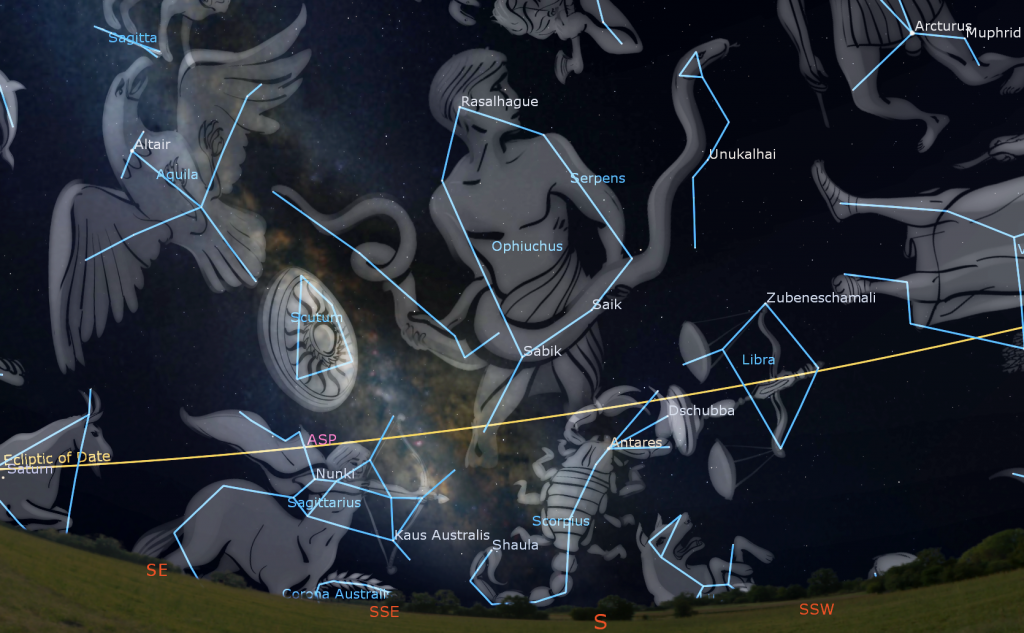
Another fact may surprise you. There is a thirteenth zodiac constellation – and July is a good time to observe it, because that’s when it’s roughly opposite from the sun in the sky. Ophiuchus (“Oh-fee-YOU-cuss”), the Serpent Bearer is a huge constellation (11th largest by area) that sits above and between the Teapot asterism of Sagittarius (the Archer) and Scorpius, and sits below Lyra (the Lyre) and Hercules. The ecliptic crosses the southernmost (lower) stars of Ophiuchus, but Ophiuchus has never been considered part of the zodiac because that would exceed the special system of 12 sky divisions important to ancient astrologers. If it were included, December babies would be Ophiuchans! In China, Ophiuchus is considered part of 天市左垣 (Tiān Shì Zuǒ Yuán), the Left Wall of the Heavenly Market Enclosure.
Ophiuchus’ stars are only medium-bright – so it’s another constellation that is better to trace out when the sky is darker. The constellation’s shape resembles a large, upright box (26° tall and 16° wide) with a pointed triangle forming the upper edge. (Think of a Dalek from Doctor Who, but without the plunger.) The constellation’s brightest star, Rasalhague “the head of the serpent charmer”, marks the peak of that triangle. Find Rasalhague below, and about midway between, the very bright stars Vega and Antares.
Immediately east and west of the main body of the Serpent-Bearer are two long sections of a separate, split-in-two constellation named Serpens. It’s the Serpent that Ophiuchus is bearing! The western (right) half is called Serpens Caput (the Snake’s Head), and the eastern (left) portion is Serpens Cauda (the Snake’s Tail). The Serpent-Bearer stands on the head of the scorpion, Scorpius. In Greek mythology, Ophiuchus saved Orion (the Hunter) from that creature’s venom. The bright stars of the Summer Triangle asterism are located to the upper left (celestial northeast) of Ophiuchus.
From east to west (left to right in the Northern Hemisphere), the stars forming the bottom of Ophiuchus’ boxy form are: medium bright Sabik “the preceding one”, dimmer Zeta Ophiuchi (or ζ Oph), and two dimmer stars a finger width apart named Yed Prior “leading hand” and Yed Posterior “trailing hand” which represent his western hand. About a palm’s width to the upper left of the two Yeds sits Marfik “the elbow”. Sabik is the star that Uranus’ northern axis of rotation points towards – the role played by Earth’s pole star, Polaris!
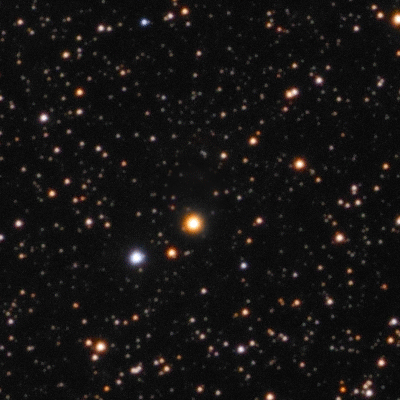
You’ll need an astronomy app and a small telescope to see it, but Ophiuchus is home to Barnard’s Star – a magnitude 9.5, red dwarf located six light-years away from us. It is the fourth closest known star, and the closest star visible from the northern hemisphere. Barnard’s Star is located 3.5 finger widths to the left (or celestial east) of Cebalrai ”shepherd’s dog”, Ophiuchus’ eastern shoulder star. Because it is so close to our solar system, we can actually watch Barnard’s Star travel through the galaxy in a process known as proper motion. It moves about half the moon’s diameter in a human lifetime.
A few medium-bright stars extending to the left of Cebalrai form the gentleman’s pipe or flute. (Or the Dalek’s disruptor!) Use binoculars to find the small, bright, open star cluster named IC 4665 located just to the upper left (or celestial north) of Cebalrai.
Because Ophiuchus sits just above the plane of the Milky Way, it is chock full of globular clusters – spherical, tightly packed groups of stars that orbit our galaxy tens of thousands of light-years away from us. A large, reasonably bright one designated Messier 10 sits just about where the Serpent-Bearer’s belt buckle would be – with a slightly dimmer one Messier 12 to its upper right. Another bright globular named Messier 107 is located just below Zeta Ophiuchi, and another named Messier 14 sits about midway between Sabik and Cebalrai. You can see the clusters in binoculars or a small telescope, especially from a dark sky site.
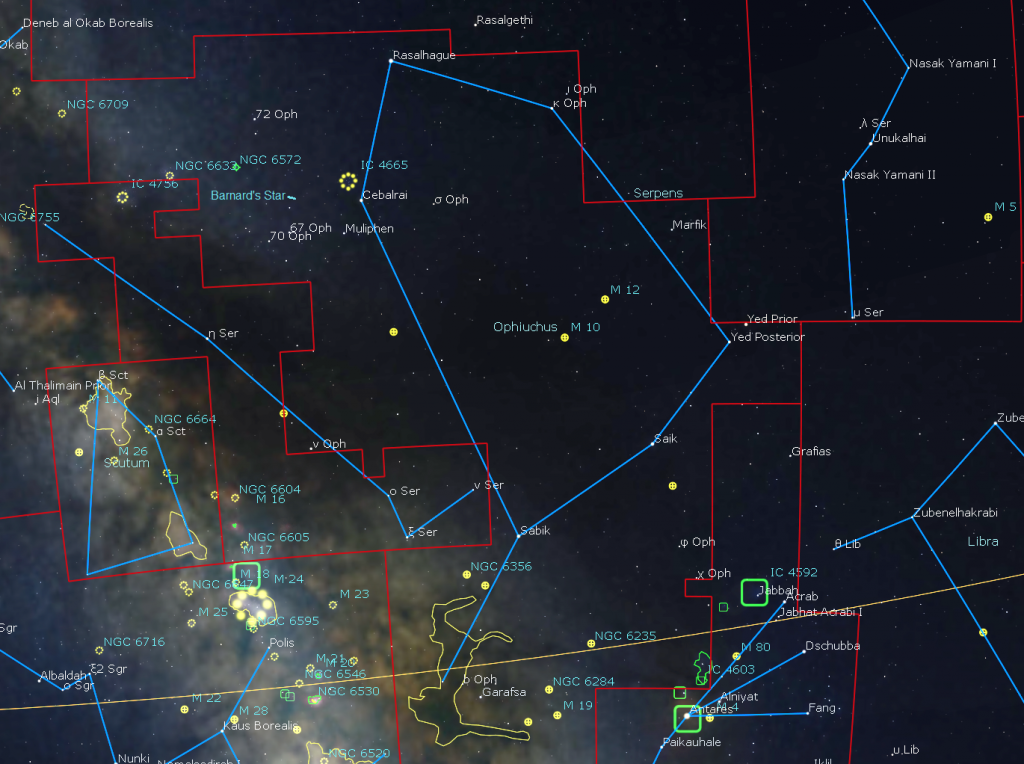
A little group of medium-bright stars, dominated by one brighter star named Garafsa or Theta Ophiuchi (or θ Oph), sit about a fist’s diameter to the lower right (or 10° to the celestial southeast) of Sabik. Those stars mark Ophiuchus’ eastern foot and are very close to the ecliptic. The Dark Horse, or Prancing Horse, is a dark region of the Milky Way that surrounds Garafsa. Measuring a fist’s diameter tall and several finger widths across, it can be captured in long exposure images. It can also be seen visually from southerly latitudes, where the constellation climbs higher in the sky.
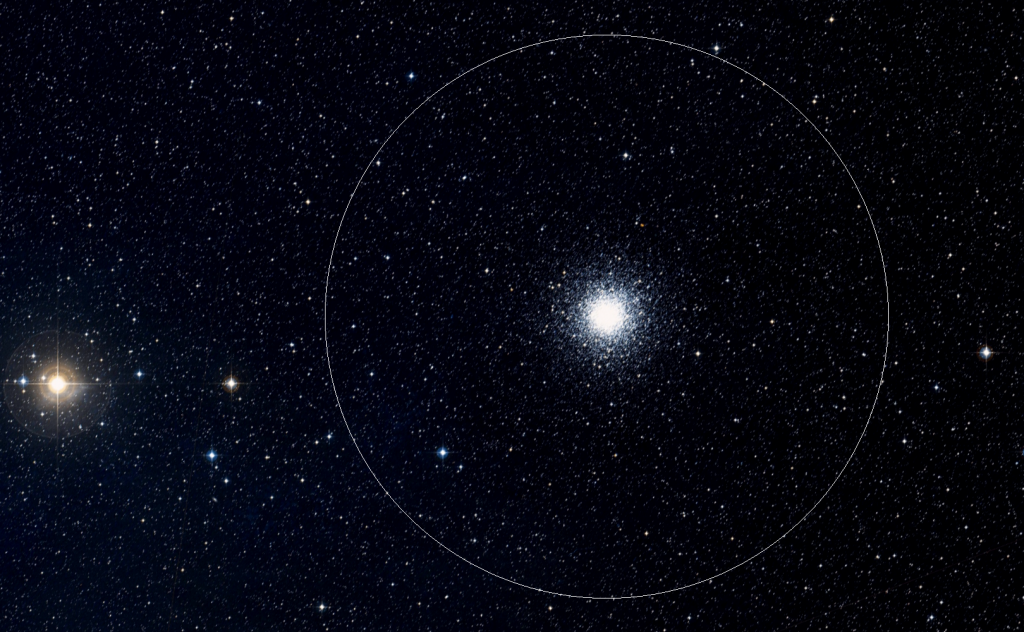
The southeastern (or bottom) part of Ophiuchus dips into the Milky Way – so there are many more star clusters there, and the star Rho Ophiuchi (or ρ Oph) in the southwestern corner of the constellation, near the bright star Antares, is gorgeous in long exposure photos. By 11 pm local time, the centre of Ophiuchus is positioned due south and about halfway up the sky. Let me know if you check it out!
Exploring Hercules
If you missed last week’s tour of Hercules, I posted it here.
Public Astro-Themed Events
Every Monday evening, York University’s Allan I. Carswell Observatory runs an online star party – broadcasting views from four telescopes/cameras, answering viewer questions, and taking requests! Details are here. Their in-person Wednesday night viewing has been converted to online via the observatory YouTube channel.
Don’t forget to take advantage of the astronomy-themed YouTube videos posted by RASC Toronto Centre and RASC Canada.
On Tuesday, July 6 from 7 to 8 pm EDT, the Dunlap Institute at University of Toronto will host their second online Astro Trivia Night. The live free event will feature lots of fun and prizes. Watch it here.
On Wednesday evening, July 7 at 7:30 pm EDT, the RASC Toronto Centre will live stream their monthly Recreational Astronomy Night Meeting at https://www.youtube.com/rasctoronto/live. Talks include the Sky This Month, variable stars, and deep space astrophotography. Details are here.
On Wednesday, July 7 at 7 pm EDT, Space Place Canada will live stream a free panel discussion entitled Canada in Orbit: The Business of Space. Details are here and watch it here.
My free, family-friendly Insider’s Guide to the Galaxy webcasts with Jenna Hinds of RASC National will return in July with a Summer Planets Spectacular! You can find more details, and the schedule of future sessions, here and here.
Keep looking up, and enjoy the sky when you do. I love questions and requests. Send me some!
One Response
perfect
thank you for a very good article